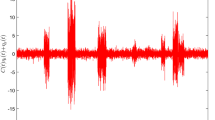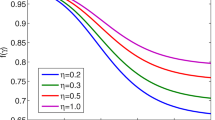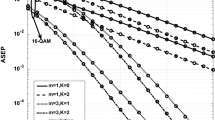Abstract
This paper presents a mathematical analysis of the joint effects of additive white Gaussian noise and gated noise in an M-ary Quadrature Amplitude Modulation communication system subject to Nakagami fading. This channel model is suitable to describe scenarios in which the Nakagami channel is affected by noisy signals originated from switching electronic circuits present in industrial environments, for example. Novel and exact analytic expressions for the bit error probability of the system are derived and computer simulations corroborate the analytic results.






Similar content being viewed by others
References
Lago-Fernández, J., & Salter, J. (July 2004). Modelling impulsive interference in DVB-T—Statistical analysis, test waveforms and receiver performance. Technical Report 299, BBC Research & Development.
Al-Dweik, A., Hazmi, A., Sharif, B., & Tsimenidis, C. (2010). Efficient interleaving technique for OFDM system over impulsive noise channels. In Proceedings of the 21st international symposium on personal indoor and mobile radio communications (PIMRC) (pp. 167–171).
Tepedelenlioğlu, C., & Gao, P. (2005). On diversity reception over fading channels with impulsive noise. IEEE Transactions on Vehicular Technology, 54(6), 2037–2047.
Vempati, S. R., Pamula, V. K., Khan, H., & Tipparti, A. K. (Jan 2013). Blind multiuser detection in Nakagami-\(m\) fading channels with impulsive noise. In Proceedings of the 4th international conference on intelligent systems modelling simulation (ISMS) (pp. 519–523).
Cheffena, M. (2012). Industrial wireless sensor networks: Channel modeling and performance evaluation. EURASIP Journal on Wireless Communications and Networking, 2012(1), 1–8.
Madi, G., Vrigneau, B., Pousset, Y., Vauzelle, R., & Agba, B. L. (August 2010). Impulsive noise of partial discharge and its impact on minimum distance-based precoder of MIMO system. In Proceedings of the XVII European signal processing conference (pp. 1602–1606), Aalbor, Denmark.
Sukanesh, R., & Sundaraguru, R. (2011). Mitigation of impulse noise in OFDM systems. Journal of Information & Computational Science, 8(12), 2403–2409.
Hikita, M., Yamashita, H., Hoshino, T., Kato, T., Hayakawa, N., Ueda, T., et al. (1998). Electromagnetic noise spectrum caused by partial discharge in air at high voltage substations. IEEE Transactions on Power Delivery, 2(13), 434–439.
Yacoub, M. D. (2000). Fading distributions and co-channel interference in wireless systems. IEEE Antennas and Propagation Magazine, 42(1), 150–160.
Agrawal, A., & Kshetrimayum, R. S. (2015). Analysis of UWB communication over IEEE 802.15.3a channel by superseding lognormal shadowing by mixture of Gamma distributions. AEÜ–International Journal of Electronics and Communications, 69(12), 1795–1799.
He, W., Lei, H., & Pan, G. (2016). Performance modeling and analysis on conditional DF relaying scheme over Nakagami-\(m\) fading channels with integral \(m\). AEÜ—International Journal of Electronics and Communications, 70(6), 743–749.
Nakagami, M. (December 1960). The \(m\)-distribution—A general formula of intensity distribution of rapid fading. In Statistical methods in radio wave propagation (pp. 3–36), Pergamon Press, Oxford.
Beaulieu, N. C., & Chen, Y. (2007). A MAP estimator for the \(m\) parameter in Nakagami fading ultra-wide bandwidth indoor channels. IEEE Transactions on Wireless Communications, 6(3), 840–844.
Lohan, E. S., Pajala, E., Renfors, M., Lakhzouri, A., & Laitinen, H. (September 2007). Indoor fading distributions for GPS-based pseudolite signals. In Proceedings of the international workshop on satellite and space communications (IWSSC’07) (pp. 6–10), Salzburg, Austria.
Souza, R. A. A., Cogliatti, R., & Yacoub, M. D. (2014). Efficient acceptance-rejection method for Nakagami-\(m\) complex samples. IEEE Wireless Communications Letters, 3(1), 94–96.
Queiroz, W. J. L., Lopes, W. T. A., Madeiro, F., & Alencar, M. S. (September 2010). An alternative method to compute the bit error probability of modulation schemes subject to Nakagami-\(m\) fading. EURASIP Journal on Advances in Signal Processing, 2010, 1–12.
Ata, S. O., & Altunbas, I. (2016). Fixed-gain AF-PLNC over cascaded Nakagami-\(m\) fading channels for vehicular communications. AEÜ–International Journal of Electronics and Communications, 70(4), 510–516.
Soury, H., Yilmaz, F., & Alouini, M. S. (October 2013). Error rates of M-PAM and M-QAM in generalized fading and generalized Gaussian noise environments. IEEE Communications Letters, 17(10), 1932–1935.
Ayat, M., Mirzakuchaki, S., & Beheshti-Shirazi, A. (August 2016). Design and implementation of high throughput, robust, parallel M-QAM demodulator in digital communication receivers. IEEE Transactions on Circuits and Systems I: Regular Papers, 63(8), 1295–1304.
Araújo, E. R., Queiroz, W. J. L., Madeiro, F., Lopes, W. T. A., & Alencar, M. S. (2015). On gated Gaussian impulsive noise in \(M\)-QAM with optimum receivers. Journal of Communication and Information Systems, 30(1), 10–20.
Goldsmith, A. (2005). Wireless communications. Cambridge: Cambridge University Press.
Cho, K., & Yoon, D. (2002). On the general BER expression of one-and two-dimensional amplitude modulations. IEEE Transactions on Communications, 50(7), 1074–1080.
Craig, J. W. (1991). A new, simple and exact result for calculating the probability of error for two-dimensional signal constellations. In Proceedings of military communications conference (MILCOM’91) (pp. 571–575).
Gradshteyn, I. S., & Ryzhik, I. M. (1979). Table of integrals, series, and products. Cambridge: Academic.
Fikioris, G. (2006). Integral evaluation using the Mellin transform and generalized hypergeometric functions: Tutorial and applications to antenna problems. IEEE Transactions on Antennas and Propagation, 54(12), 3895–3907.
Pearson, J. (September 2009). Computation of hypergeometric functions. Master’s thesis, Worcester College, University of Oxford, Oxford.
Robalo, T. C. G. (2006). Séries Hipergeométricas Generalizadas no Contexto da Teoria das Funções Hipercomplexas. Master’s thesis, Universidade de Aveiro, Aveiro.
Queiroz, W. J. L., Alencar, M. S., Lopes, W. T. A., & Madeiro, F. (October 2010). Error probability in multichannel reception with \(M\)-QAM, \(M\)-PAM and R-QAM schemes under generalized fading. IEICE Transactions on Communications, E93-B(10), 2677–2877.
Queiroz, W. J. L., Madeiro, F., Lopes, W. T. A., & Alencar, M. S. (May 2013). Performance analysis of generalized QAM modulation under \(\eta -\mu \) and \(\kappa -\mu \) fading. EURASIP Journal on Advances in Signal Processing, 2013(1), 1–10.
Alouini, M. S., & Goldsmith, A. J. (1999). A unified approach for calculating error rates of linearly modulated signals over generalized fading channels. IEEE Transactions on Communications, 47(9), 1324–1334.
Ropokis, G. A., Rontogianis, A. A., Mathiopoulos, P. T., & Berberidis, K. (September 2010). An exact performance analysis of MRC/OSTBC over generalized fading channels. IEEE Transactions on Communications, 58(9), 2486–2492.
Ulusoy, A. H., & Rizaner, A. (April 2008). Adaptive path selective fuzzy decorrelating detector under impulsive noise for multipath fading CDMA systems. IEEE Communications Letters, 12(4), 228–230.
Liu, X., & Bialkowski, M. E. (2010). Effect of antenna mutual coupling on MIMO channel estimation and capacity. International Journal of Antennas and Propagation, 2010, 1–9. Article ID 306173.
Acknowledgements
The authors would like to express their thanks to the National Council for Research and Development (CNPq), the Coordination for the Improvement of Higher Education Personnel (CAPES), the Institute of Advanced Studies in Communications (Iecom), the Graduate Program in Electrical Engineering, Federal University of Campina Grande (PPgEE), and the Graduate School of Electrical Engineering, Federal University of Bahia (PPGEE), for the financial support of this research.
Author information
Authors and Affiliations
Corresponding author
Rights and permissions
About this article
Cite this article
Queiroz, W.J.L., Madeiro, F., Lopes, W.T.A. et al. On the performance of M-QAM for Nakagami channels subject to gated noise. Telecommun Syst 68, 1–10 (2018). https://doi.org/10.1007/s11235-017-0371-7
Published:
Issue Date:
DOI: https://doi.org/10.1007/s11235-017-0371-7




